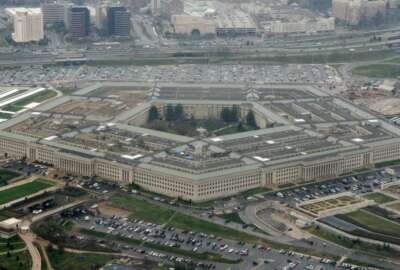
Pentagon putting more data behind IT modernization decisions
Danielle Metz, the DoD deputy chief information officer for information enterprise, said the revamped IT portfolio management process will integrate with the Do...
As the Defense Department digs out of its mound of technical debt, the office of the chief information officer is ensuring military services and defense agencies receive value for these new investments.
DoD is implementing a revamped approach to IT portfolio management to better connect investments to mission requirements.
Danielle Metz, the DoD deputy chief information officer for information enterprise, said the new framework will integrate with DoD business processes to enforce recommendations for optimization and modernization.

“We will enable the DoD CIO to track what IT capabilities are non-compliant with policies, strategies and architectures. What portion of the DoD IT budget is aligned to non-compliant capabilities, and what capabilities are executing modernization plans,” Metz said during ATARC’s digital transformation event yesterday. “We are developing metrics and targets to track the improvement of data sources that are critical as supporting this framework. These metrics will address the data quality of each authoritative data source, the optimization of the data sources themselves and the interoperability between data sources and other duty platforms. We will then integrate the IT portfolio management process with the DoD budget cycle to ensure resources reflect IT portfolio management decisions, and that resulting initiatives have the funding they require.”
Metz said this portfolio management approach will lead to better decisions by tying budget data to IT performance and technology strategic plans.
DoD’s IT portfolio management approach dates back to at least 2005, if not before that. But what the Pentagon is doing now is moving from more of a planning document to an approach that is data driven.
Metz didn’t offer any insights into when, or if, the framework would be made public.
The decision to improve the current process, however, came from DoD’s progress to close and optimize data centers and move to the cloud.
“Since 2010, the DoD has closed over 1,400 data centers with hundreds more scheduled to close as systems continue to migrate to more effective, efficient and secure environments,” Metz said. “In late 2018, my office focused on cloud adoption in data center consolidation with 14 defense agencies and field activities, as part of DoD’s IT reform activities. We started this initiative in earnest with a goal of moving 960 individual systems to targeted cloud environments, and closing 60 data centers by fourth quarter of fiscal 2021. Today, we have completed 80% of our goal on target and have action plans in place to complete the remaining 20% by next year.”
Metz added because of this progress more and more service members have the ability to take advantage of modern compute and storage capabilities, and build apps in the cloud.
Enterprisewide DevSecOps
The other thing moving to the cloud is doing for DoD is opening the door to delivering faster software capabilities through DevSecOps.
DoD and the military services have been focused on moving to DevSecOps for some time. The Air Force’s Platform One capability and corresponding software factory is one of several examples.
Metz said she is the co-chairwoman along with the undersecretaries of acquisition and sustainment, and research and engineering of the software modernization senior steering group. The group’s goal is to accelerate DevSecOps adoption through the department by updating IT and acquisition policies and offering enterprisewide platforms.
“Right now, different DoD components manage many of the departments, networks, data centers and clouds. By consolidating these various efforts at the enterprise level, we will enable the CIOs to provide greater security and ensure greater reliability of the department’s digital infrastructure,” she said. “Our software modernization and cloud initiative, like many of our current efforts, relies heavily on engagement and continuous collaboration across the department with DoD components and military services. We are working to normalize joint efforts versus individual achievements, so that we can ensure interoperability and security, field enterprise capabilities, reduce administrative burden of multiple acquisitions and realize economies of scale.”
One recent example of this type of enterprisewide approach is the commercial remote environment (CVR) platform launched last year during the pandemic. DoD has used CVR as both a success story and jumping off point for offering more secure, enterprise capabilities.
Metz said this effort, which was the largest deployment of Microsoft Teams in the world, served as a catalyst for the latest effort called DoD 365.
“Later this summer or early fall, we plan to introduce additional capabilities for managing personal devices, including mobile, desktop or laptop access to DoD 365. Without the user needing to be on the Non-Secure Internet Protocol Routing Network (NIPRNet),” she said. “Most recently, we focused on developing an Impact Level 6 environment for DoD 365 so that DoD personnel working on the secure network and in secure facilities can have the same capabilities as those working on the unclassified network. The IL6 environment will provide all DoD employees with the same secure office capabilities and transform how they collaborate in the secure environments.”
At the same time, the Defense Information Systems Agency also reiterated yesterday that it would begin shutting down the Defense Collaboration Services Program as of Sept. 1, except for the DCS Chat and Web Conference capabilities on the Secure Internet Protocol Router Network (SIPRNet), which will remain operational until fiscal 2023.
DISA said the DCS Program Office will take a phased approach in decommissioning the service, synchronized with the department’s adoption of Microsoft Office 365 cloud-based services to allow for no disruption for those still using the capabilities.
Copyright © 2024 Federal News Network. All rights reserved. This website is not intended for users located within the European Economic Area.
Jason Miller is executive editor of Federal News Network and directs news coverage on the people, policy and programs of the federal government.
Follow @jmillerWFED
Related Stories

Digital modernization never finished for DISA, but chasing trends isn’t the answer






